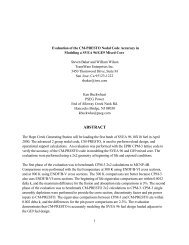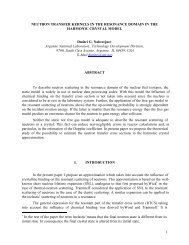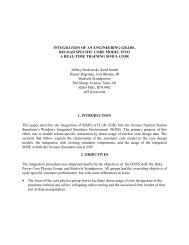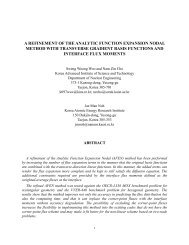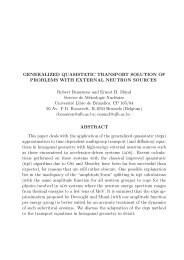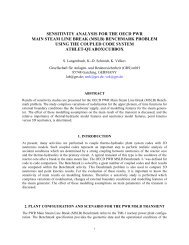Ellis
Ellis
Ellis
Create successful ePaper yourself
Turn your PDF publications into a flip-book with our unique Google optimized e-Paper software.
The densities and isotopic compositions of actual MOX fuel to be considered in future<br />
applications will be different from these simple sample models. Accordingly, for consistency, a<br />
series of HELIOS cases was performed with standardized LEU, WG, and RG compositions. All<br />
the fuel was assumed to be 10.4 g/cm 3 , and for MOX fuel Pu-content was defined as total Pu<br />
wt% in total heavy element inventory (U+Pu). The vector for reactor grade Pu (RG) is assumed<br />
to be: 1% 238 Pu, 59% 239 Pu, 24% 240 Pu, 11% 241 Pu, and 5% 242 Pu. The vector for weapons grade<br />
Pu (WG) is assumed to be 0.05% 238 Pu, 94.3% 239 Pu, 5.0% 240 Pu, 0.6% 241 Pu, and 0.05% 242 Pu.<br />
For the following series of calculations, MOX loadings of 2, 4, 6, 8, 10, 12, 14, 16, 18, and 20<br />
wt% Pu were modelled, LEU enrichments of 2, 4, 6, 8, 10, 12, 14, 16, 18, and 20 wt% 235 U were<br />
considered. The level of natural boron in the coolant is assumed to be 600 ppm. The<br />
calculations were performed for void levels ranging from 0 - 100% in intervals of 10%.<br />
The attached Figures 6-8 show curves of calculated void reactivities as functions of void for<br />
LEU, WG, and RG fuel, for fresh and the midburnup (equilibrium) burnup levels. For each fuel<br />
type, the curves are shown for a large number of MOX loadings or enrichment levels. From the<br />
large set of data gathered in these studies, three representative examples are tabulated for the<br />
void reactivity and void reactivity coefficients for LEU, WG, and RG fuel. The results are<br />
summarized in Tables VI and VII.<br />
Table VI. Void Reactivity Effects (%) for Fresh and Midburnup Fuel<br />
Fuel<br />
10% void 50% void 100% void<br />
¨© § ¢¡£¤§¦ ¨© ¢¡¢£¤§¦ ¨© § ¡£¤§¦ ¨© ¢¡¢£¥¤§¦ ¨© § ¢¡£¤§¦ ¨©<br />
¢¡¢£¥¤§¦<br />
LEU 4 wt% -1.104 -1.761 -9.765 -14.088 -69.820 -73.835<br />
WG MOX 6 wt% -1.286 -1.628 -9.021 -10.691 -33.146 -32.939<br />
RG MOX 8 wt% -1.332 -1.441 -7.549 -8.039 -18.898 -17.870<br />
For 10% voiding, the void reactivity for WG and RG are similar, and more negative than LEU,<br />
for fresh fuel. For midburnup fuel, LEU is more negative while RG is least negative. For 100%<br />
voiding in fresh fuel, LEU has a much more negative void reactivity effect than MOX, and RG<br />
has the least negative. For midburnup fuel, the voiding reactivity effect for 100% voiding<br />
becomes more negative in LEU but becomes somewhat less negative in WG and RG.<br />
As seen in the curves in the Figures 6-8, the reactivity behavior of the different types of MOX<br />
and LEU fuel changes as the enrichment or MOX Pu content changes. An interesting threshold<br />
figure-of-merit (FOM) to consider is the calculated minimum enrichment or MOX loading at<br />
which the reactivity effect becomes positive upon voiding for the three fuel types. This FOM is<br />
tabulated in Table VII for LEU, WG MOX and RG MOX.<br />
Table VII. Minimum Fuel Enrich. or Pu Loading at Which Voiding Reactivity Becomes Positive.<br />
Fuel Type MOX loading or<br />
enrichment (wt%)<br />
LEU 20.0<br />
WG MOX 12.8<br />
RG MOX 12.4<br />
8



